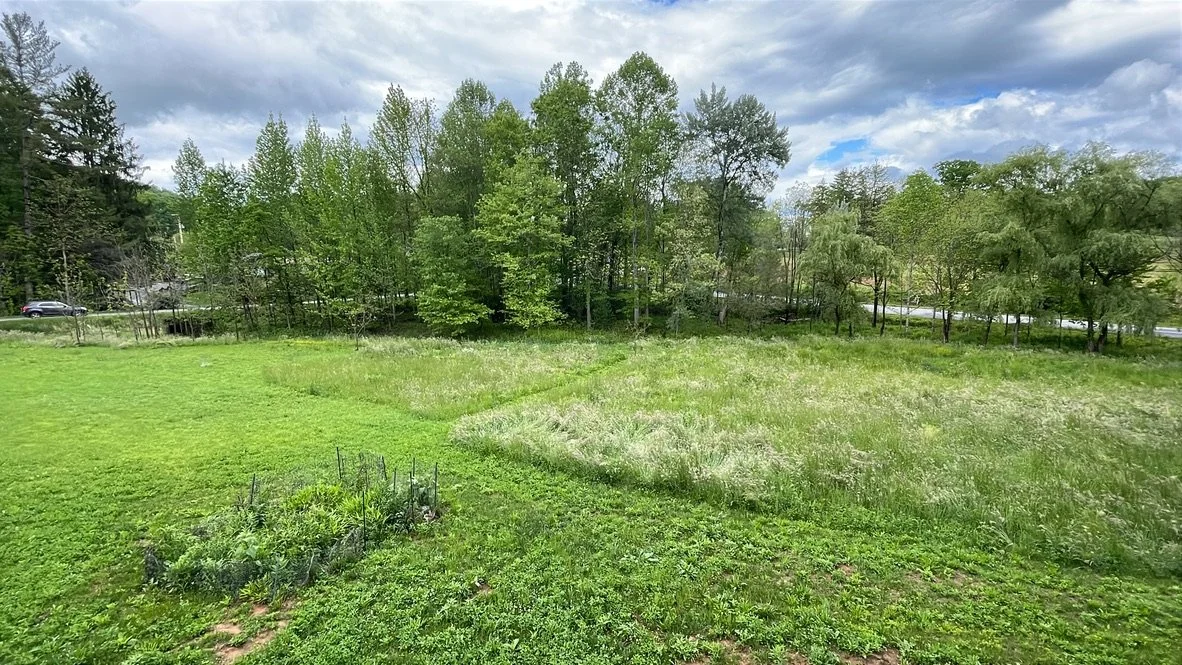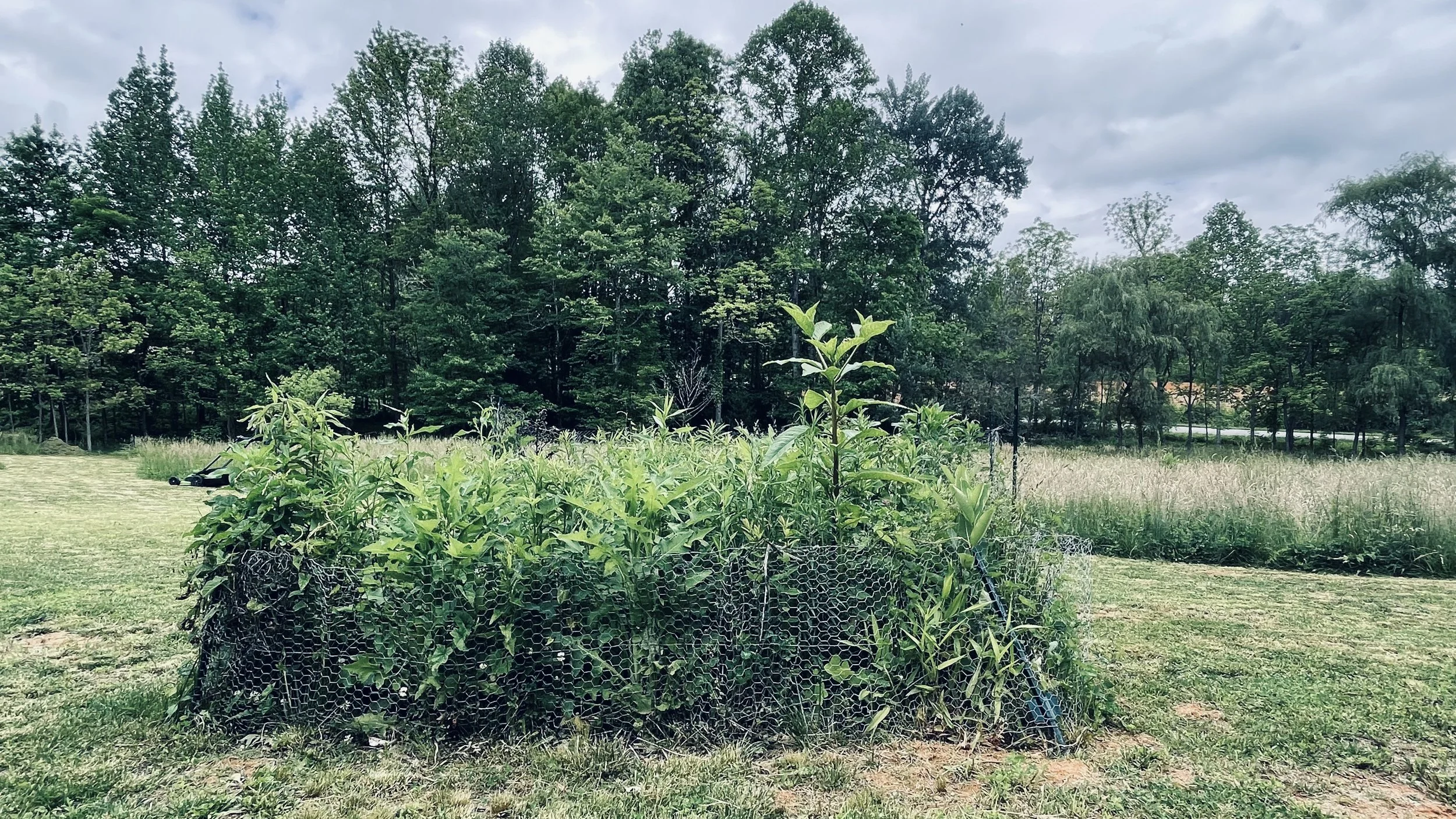And so it goes
Meadow, creek, woods, May 2025
It is late spring, towards the end of May. Things are growing, everything is green. Some plants are flowering, some have fruit on them. I can no longer see through the woods, now a thick, verdant-leaf wall against the sky. The grasses are tall on this side of the creek. They bend in lush waves across the meadow, a green tide moving from side to side.
The work of last spring and last fall, and even over the winter, is evident in the landscaped beds near the house. Last year’s struggling sochan is a large emerald bush. Unripe blueberries are camoflauged against similarly-hued leaves, now under a net to keep away hungry birds. The surviving mountain laurel burst into flames of fushia. Weeds that previously overwhelmed the beds are mostly gone. I can no longer indulge the bright yellow buttercups strangling my newly flowering yarrow. A few rabbit-damaged plants look like they might survive to bloom again. Most of the raspberry plants given to me last summer survived, some spread, and I transplanted those into the spaces where the others didn’t make it. I added marigolds to keep out pests, and eventually I will add alliums or chives. The 17-gauge wire, purchased to fence in the raspberry vines as they grow, is waiting to find its way around the green posts.
Strawberry and raspberry
No new self-seeded blooms have risen up through the clover jungle overwhelming last year’s small sunflower bed. As I had wished they might. I am content to leave it be for now. Plenty of bees and caterpillars visit.
A half-dozen strawberry plants, thinned out from another garden and given to me last spring, are a special delight. After over a year of hoping they would stay alive, their white blossoms have turned into delicious red bounty. Though I won’t be making jam or freezing them, they yield a pint or more every day to have with yogurt and salads or to eat just by themselves. Bugs get to some of them before I can, but these are left out for other critters who come by, the bunnies perhaps. A new fig tree stands near the strawberries where the old one withered away. Fingers crossed.
Two persimmon trees and at least one oak tree at the edge of the meadow look robust in the morning sunshine. One of the chestnut trees may have some new growth coming from the ground. New growth is showing on two of our replanted Christmas trees.
Oak, pine, persimmon
Along the creek, the trees are doing better. Two transplanted white pines have new growth shooting up. A small juniper looks healthy. A mulberry tree that I propagated myself from cuttings from another tree had tiny red fruit on it. A small elderberry brought here from Chapel Hill is thriving close to the mulberry. At least a couple of my new willow trees rooted from severed limbs of storm-damaged trees look sturdy; the others may be too willowy to make it, but the jury is not out yet. The red and the yellow twig dogwoods that were nearly destroyed by Hurricane Helene’s deluge are standing tall, as are their newer companions, and flowering now as a matter of fact.
Most of my landscape maintenance routine consists of going out to check on each plant I have added to this already abundant landscape. I admire each tree and coax it to keep growing, weeding around them as I do so.
One of my big plans early on, now that I had a place that gets more sunshine than any yard I ever had in my entire life, was to put in a vegetable garden in one of the spots where new grass had not started to grow. However, I quickly abandoned the small plot that I had fenced and planted, realizing it was too far away from the house to make watering feasible. But, I kept the fence up and the compost pile, and let it go wild inside the fence.
It quickly became my research lab for what grows in the ground without intervention. I spent lots of time with my plant ID app out there learning the names of plants, and anything else about them of interest. Now, it is its own little meadow in the middle of the mowed parts of the yard. It will be a riot of color soon and will be covered by butterflies, and bees will dive bomb into the bright white flowers of the bindweed that weaves through the fencing and skims the top of everything else. And all of it will all die back in the winter. And come back in the spring.
Mini-meadow
There are herbs and some perennial flowers along the house on either side of the small back porch of the bedroom. It is on my mind to try a couple of raised beds for vegetables closer to my back door, where a side yard is evolving, now with benches and a small fire pit. It seems doable, and I will let this idea linger, until one day, I find myself actually buying the beds and the seeds and moving some dirt.
— o—
As I return to each season in this second year of living near the woods*creek*meadow, I am finding myself a bit less overwhelmed by all the possibilities of what I need to do. I am more relaxed about what this place does for itself. At the same time I feel welcomed to be part of it, to collaborate as I become more familiar with what I can best contribute.



